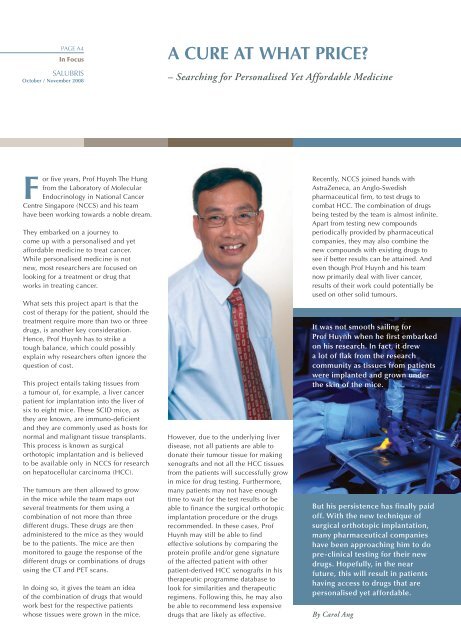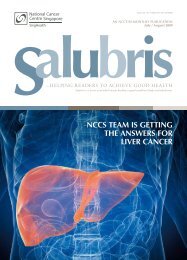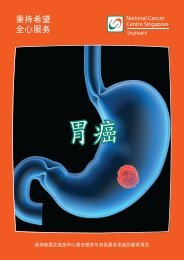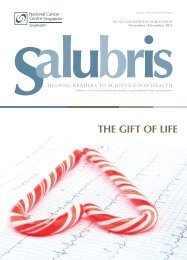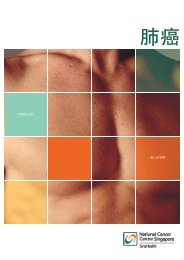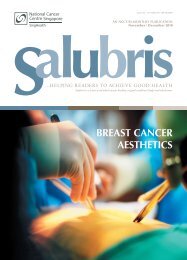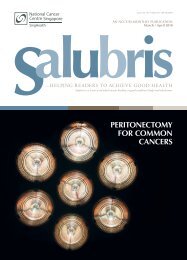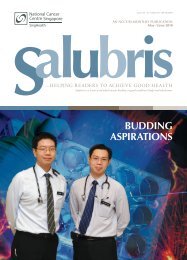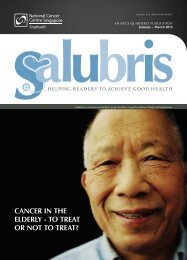Public Version - National Cancer Centre Singapore
Public Version - National Cancer Centre Singapore
Public Version - National Cancer Centre Singapore
Create successful ePaper yourself
Turn your PDF publications into a flip-book with our unique Google optimized e-Paper software.
Page A4<br />
In Focus<br />
SALUBRIS<br />
October / November 2008<br />
A Cure at what Price?<br />
– Searching for Personalised Yet Affordable Medicine<br />
For five years, Prof Huynh The Hung<br />
from the Laboratory of Molecular<br />
Endocrinology in <strong>National</strong> <strong>Cancer</strong><br />
<strong>Centre</strong> <strong>Singapore</strong> (NCCS) and his team<br />
have been working towards a noble dream.<br />
They embarked on a journey to<br />
come up with a personalised and yet<br />
affordable medicine to treat cancer.<br />
While personalised medicine is not<br />
new, most researchers are focused on<br />
looking for a treatment or drug that<br />
works in treating cancer.<br />
What sets this project apart is that the<br />
cost of therapy for the patient, should the<br />
treatment require more than two or three<br />
drugs, is another key consideration.<br />
Hence, Prof Huynh has to strike a<br />
tough balance, which could possibly<br />
explain why researchers often ignore the<br />
question of cost.<br />
This project entails taking tissues from<br />
a tumour of, for example, a liver cancer<br />
patient for implantation into the liver of<br />
six to eight mice. These SCID mice, as<br />
they are known, are immuno-deficient<br />
and they are commonly used as hosts for<br />
normal and malignant tissue transplants.<br />
This process is known as surgical<br />
orthotopic implantation and is believed<br />
to be available only in NCCS for research<br />
on hepatocellular carcinoma (HCC).<br />
The tumours are then allowed to grow<br />
in the mice while the team maps out<br />
several treatments for them using a<br />
combination of not more than three<br />
different drugs. These drugs are then<br />
administered to the mice as they would<br />
be to the patients. The mice are then<br />
monitored to gauge the response of the<br />
different drugs or combinations of drugs<br />
using the CT and PET scans.<br />
In doing so, it gives the team an idea<br />
of the combination of drugs that would<br />
work best for the respective patients<br />
whose tissues were grown in the mice.<br />
However, due to the underlying liver<br />
disease, not all patients are able to<br />
donate their tumour tissue for making<br />
xenografts and not all the HCC tissues<br />
from the patients will successfully grow<br />
in mice for drug testing. Furthermore,<br />
many patients may not have enough<br />
time to wait for the test results or be<br />
able to finance the surgical orthotopic<br />
implantation procedure or the drugs<br />
recommended. In these cases, Prof<br />
Huynh may still be able to find<br />
effective solutions by comparing the<br />
protein profile and/or gene signature<br />
of the affected patient with other<br />
patient-derived HCC xenografts in his<br />
therapeutic programme database to<br />
look for similarities and therapeutic<br />
regimens. Following this, he may also<br />
be able to recommend less expensive<br />
drugs that are likely as effective.<br />
Recently, NCCS joined hands with<br />
AstraZeneca, an Anglo-Swedish<br />
pharmaceutical firm, to test drugs to<br />
combat HCC. The combination of drugs<br />
being tested by the team is almost infinite.<br />
Apart from testing new compounds<br />
periodically provided by pharmaceutical<br />
companies, they may also combine the<br />
new compounds with existing drugs to<br />
see if better results can be attained. And<br />
even though Prof Huynh and his team<br />
now primarily deal with liver cancer,<br />
results of their work could potentially be<br />
used on other solid tumours.<br />
It was not smooth sailing for<br />
Prof Huynh when he first embarked<br />
on his research. In fact, it drew<br />
a lot of flak from the research<br />
community as tissues from patients<br />
were implanted and grown under<br />
the skin of the mice.<br />
But his persistence has finally paid<br />
off. With the new technique of<br />
surgical orthotopic implantation,<br />
many pharmaceutical companies<br />
have been approaching him to do<br />
pre-clinical testing for their new<br />
drugs. Hopefully, in the near<br />
future, this will result in patients<br />
having access to drugs that are<br />
personalised yet affordable.<br />
By Carol Ang


